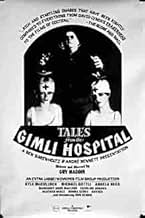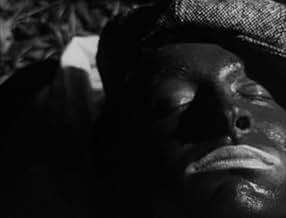Tales from the Gimli Hospital
- 1988
- 1h 12min
NOTE IMDb
6,6/10
1,6 k
MA NOTE
Ajouter une intrigue dans votre langueWhile their mother is dying in the modern Gimli, Manitoba hospital, two young children are told a tale by their Icelandic grandmother about Einar the Lonely, his friend Gunnar, and the angel... Tout lireWhile their mother is dying in the modern Gimli, Manitoba hospital, two young children are told a tale by their Icelandic grandmother about Einar the Lonely, his friend Gunnar, and the angelic Snjofridur in a Gimli of old.While their mother is dying in the modern Gimli, Manitoba hospital, two young children are told a tale by their Icelandic grandmother about Einar the Lonely, his friend Gunnar, and the angelic Snjofridur in a Gimli of old.
- Réalisation
- Scénario
- Casting principal
- Récompenses
- 1 nomination au total
Ron Eyolfson
- Pastor Osbaldison
- (as Ronald Eyolfson)
- …
Avis à la une
I can't think of a better introduction to eccentric Canadian auteur Guy Maddin than "Tales from the Gimli Hospital". Maddin's feature debut is as ingeniously bizarre and surreal as many of his later followings and despite being a bit rough around the edges it is more than deserving of its devoted cult following which regard it as one of the best films of the 80's. I can't agree with that particular statement but it is unquestionably one of the most unique and interesting films of the decade, and certainly among the more memorable Canadian films to emerge during the time period.
While two children are witnessing their mother's slow death in a modern-day hospital in Gimli, Manitoba, they are told a story by their grandmother set in Gimli many years before. The story is a fascinating and complex one, echoing a parable at times and at others simply bizarre. Often compared to David Lynch's "Eraserhead", "Tales from the Gimli Hospital" is a far more straightforward film, actually, and one with a narrative that requires interpretation but can be followed quite easily. It is an interesting parallel to Lynch's debut, however.
As noted previously the film is rough around the edges in terms of budget and other constraints and Maddin isn't as comfortable and confident a director as he would later become, but the film works wonderfully as a whole and comes highly recommended.
8/10
While two children are witnessing their mother's slow death in a modern-day hospital in Gimli, Manitoba, they are told a story by their grandmother set in Gimli many years before. The story is a fascinating and complex one, echoing a parable at times and at others simply bizarre. Often compared to David Lynch's "Eraserhead", "Tales from the Gimli Hospital" is a far more straightforward film, actually, and one with a narrative that requires interpretation but can be followed quite easily. It is an interesting parallel to Lynch's debut, however.
As noted previously the film is rough around the edges in terms of budget and other constraints and Maddin isn't as comfortable and confident a director as he would later become, but the film works wonderfully as a whole and comes highly recommended.
8/10
The comments made above by "Spearin" express my own reaction to this film.
I rented it on DVD because it sounded intriguing, but fully expected to yank the disc before it fairly got underway. To my pleased surprise, I was caught up in the story and captivated by the photography from the first seconds, and thoroughly enjoyed the experience--so much so, in fact, that I immediately replayed the movie with the director's often droll narration superimposed.
Also on the DVD I rented was a short film by the same author, "The Dead Father," which is well worth watching. It, perhaps even more than "Tales from the Gimli Hospital," evokes early French surrealist film, but not in a slavish way.
Both films gave me food for thought--about film and about human relationships. I guess this "nourishment" aspect of film-viewing is my basic criterion for judgment. On that basis, I voted an "eight" for "Tales from the Gimli Hospital."
By the way, I was very interested to learn (from the director's commentary) some of the actual history of Gimli and its settlers. These were tough, courageous people.
I rented it on DVD because it sounded intriguing, but fully expected to yank the disc before it fairly got underway. To my pleased surprise, I was caught up in the story and captivated by the photography from the first seconds, and thoroughly enjoyed the experience--so much so, in fact, that I immediately replayed the movie with the director's often droll narration superimposed.
Also on the DVD I rented was a short film by the same author, "The Dead Father," which is well worth watching. It, perhaps even more than "Tales from the Gimli Hospital," evokes early French surrealist film, but not in a slavish way.
Both films gave me food for thought--about film and about human relationships. I guess this "nourishment" aspect of film-viewing is my basic criterion for judgment. On that basis, I voted an "eight" for "Tales from the Gimli Hospital."
By the way, I was very interested to learn (from the director's commentary) some of the actual history of Gimli and its settlers. These were tough, courageous people.
Fans of David Lynch and early Luis Buñuel will find plenty to admire (or scratch their head at) in this esoteric, shoestring budget mock Icelandic folk tale, set in a bleak sub-arctic village where victims of a mysterious plague are treated by having their sores caressed with dead seagulls. Winnipeg director Guy Maddin borrows extensively from the primitive vocabulary of the early sound era (with grainy photography, a scratchy music score, and crude post-dubbed dialogue) to create a nonsensical 70-minute punchline with no joke attached. The antique style of the production would have to be considered its own reward, especially since the story itself (involving incest, hints of necrophilia, and a mysterious butt-grabbing duel to the death) leads nowhere in particular. The awkward emoting by Nordic characters named Gunnar, Snjofridur, and Einar the lonely; the Louise Brooks look-alike nurses; and the cameo appearance of a black-faced vaudeville minstrel are all reminiscent of some nightmarish, early 1930s melodrama, but Maddin's aesthetic is aimed squarely at today's midnight cult audiences.
Here's a movie that took its miniscule budget and really made the most of it.
How? Well, take a look at the looping synchronization. It can't be done well without being expensive, so they do very little of it, and get around the problem by shooting characters from obtuse angles that hide the problem. Color's expensive too, so it's in black and white. And music? You can hear the needle drop on the record.
But the money they spent went in the right areas. The visuals are so strong and the camera placement sometimes so unexpected that you find yourself wondering what it is you're looking at--and then something moves, and the tableau breaks apart into a conventional scene. The opening sequence, a long sfx pan down to the Gimli hospital, going through clouds and angels, evokes the 1940s so well that you halfway expect to see William Bendix in one of the beds. The costuming is strange and the plot seems totally unworkable, and yet it pulls you in and keeps you there, never seems to make a horrible misstep, and at times hits exactly what it's aiming for.
Sure it's an amateur film. But look at the nice smooth camera work, the well-paced editing, the good choices in music for mood. While it's all too easy to cite Cocteau, Blood of a Poet comes to mind often while watching Tales from the Gimli Hospital, thanks to the surprising interruption of the narrative by little bits of surreal magic. You don't walk away from this one saying that it could have been done better--instead, you wonder how it was done so well for so little.
How? Well, take a look at the looping synchronization. It can't be done well without being expensive, so they do very little of it, and get around the problem by shooting characters from obtuse angles that hide the problem. Color's expensive too, so it's in black and white. And music? You can hear the needle drop on the record.
But the money they spent went in the right areas. The visuals are so strong and the camera placement sometimes so unexpected that you find yourself wondering what it is you're looking at--and then something moves, and the tableau breaks apart into a conventional scene. The opening sequence, a long sfx pan down to the Gimli hospital, going through clouds and angels, evokes the 1940s so well that you halfway expect to see William Bendix in one of the beds. The costuming is strange and the plot seems totally unworkable, and yet it pulls you in and keeps you there, never seems to make a horrible misstep, and at times hits exactly what it's aiming for.
Sure it's an amateur film. But look at the nice smooth camera work, the well-paced editing, the good choices in music for mood. While it's all too easy to cite Cocteau, Blood of a Poet comes to mind often while watching Tales from the Gimli Hospital, thanks to the surprising interruption of the narrative by little bits of surreal magic. You don't walk away from this one saying that it could have been done better--instead, you wonder how it was done so well for so little.
I picked up this movie since I live in Gimli, and have heard interesting things about Guy Maddin. Though certainly a strange and surrealist film, it is also a monument and critique of Icelandic culture, and Gimli, where he had a summer cottage. If you know the history of Gimli, and are familiar with Icelandic culture, certain parts of the film do not seem strange at all. I would be interested in knowing how people not knowing these things interpreted things like the marriage across the river, or the food served at the hospital. I am in love with the aesthetics of it. He has been able to capture the exact look of early films, right down to actors and costuming, yet this doesn't seem to take over the film. Though I am personally a bigger fan of Maddin's short films, I enjoyed trying to work my way through this.
Le saviez-vous
- AnecdotesAccording to Guy Maddin the plot of Tales from the Gimli Hospital (1988) was inspired by "The Eternal Husband," by Fyodor Dostoevsky, and Maddin's own experience of cuckolding a friend.
- ConnexionsFeatured in Guy Maddin: En attendant le crépuscule (1997)
Meilleurs choix
Connectez-vous pour évaluer et suivre la liste de favoris afin de recevoir des recommandations personnalisées
- How long is Tales from the Gimli Hospital?Alimenté par Alexa
Détails
Box-office
- Budget
- 25 000 $US (estimé)
- Durée
- 1h 12min(72 min)
- Couleur
- Mixage
- Rapport de forme
- 1.37 : 1
Contribuer à cette page
Suggérer une modification ou ajouter du contenu manquant






















